The first 3 installments of this series focused on why children are the way they are as well as the establishment of a working rapport among children, parents, and the dentist. Considerable time was devoted to the principle that educating child-patients and parents is as important as providing quality treatment, and that making the effort to establish a one-on-one patient/doctor relationship in the absence of parents will enhance the chances of a child’s pleasant and productive visit to the dentist.
Let’s turn now to some clinical pediatric treatment issues that I feel are paramount for the dentists, dental assistants, and hygienists who care for children. I’ve selected certain specific issues for discussion based on the prevalence of questions I receive from my seminar participants and video viewers. What follows is not intended as a be-all/end-all pediatric dental manual. There are textbooks I recommend that serve as excellent basic resources for the whole gamut of pediatric dental therapeutics.
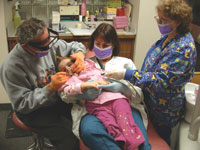 |
| Figure 1. Nonmedicated toddler in the lap of a dental assistant in preparation for operative dentistry. |
In deference to the changing times, “hand-over-the-mouth” procedures to stop crying are not recommended. Don’t say, “Stop crying!” Don’t say, “You can’t leave until you’re good!” Don’t be confrontational. Instead ask, “What’s the matter? Why are you crying? Why are you sad? What do you want?” Listen to what the child says and respond accordingly. “I want my mommy” is a frequent reply. “Of course you do,” you answer. “Show me how you brush your teeth and you have to go! You can’t sleep over!” The child wants to go, and you want the child to go. No problem!
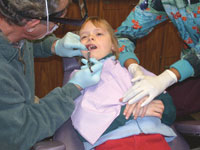 |
| Figure 2. “Berman battle stations.” Note passive control positions of dental assistant and dentist with patient in more upright posture. |
The most effective method of incorporating passive control of all child-patients, cooperative or reluctant, is what I term “the battle stations position” (Figure 2). The child is in the chair in a more upright position, not lying down. The dental assistant rests an arm on the patient’s shoulder next to the head, which acts as a passive deterrent to the dreaded sudden head-swing. The dental assistant rests the other hand on the patient’s hands, which are folded across the stomach. The dentist assumes his or her position using comfortable hand position and finger rests. Don’t hesitate to rest fingers inside the mouth for greater control and protection for the child’s tongue and lips. Employing a rubber dam is another alternative, but I prefer the hands-on finger controls. When working from behind the patient, the child’s head is tucked securely but softly into the dentist’s chest. Don’t forget the importance of surrounding the target tooth with gentle finger rest protection.
Very importantly, you must maintain the child’s attention by talking incessantly and by making eye contact. When the child’s eyes are closed, imagination takes over, and the senses of hearing, smell, touch, etc are heightened, thereby magnifying the vibration and the noise, which can be very disconcerting.
Special note: The controversy over the employment of mind-altering drugs (premedication and conscious sedation, nitrous oxide, etc) versus the behavioral approach continues. The more confident and comfortable you feel with a child-patient, the less you’ll need pharmacologic alternatives. When questioned on the subject, pediatric dentists clearly state that the longer they’re in practice, the less they rely on drugs to control their patients. Remember, putting a child to sleep does not cure phobia. It’s merely a means for the dentist to get through the procedure. If patient education is a goal, the child learns nothing very positive from the experience.
As discussed in the earlier installments of this series, an important obligation of the dentist to a patient, especially a child, is education. A drugged child does not derive the full educational benefit of a visit to the dentist. The 2-way relationship is short-circuited. Employing voice control, facial expression, and positive body language can carry the day.
THE SHOT
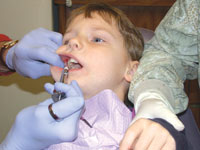 |
| Figure 3. Child receiving infiltration. Eyes are open. Note relaxed lips, soft tissues, and dentist’s finger rests. |
The shot is the singularly defining moment in the dentist/patient relationship. Much of the previsit phobia on the part of both the patient and the dentist focuses on the anticipation of the shot. So every effort must be made to administer the local anesthesia smoothly and painlessly. Topical anesthesia is helpful, but the injection technique is critical. For infiltrations, the patient should be biting the teeth together so the soft tissues are in a relaxed mode. This enables you to pull or wiggle the tissues into the needle instead of “sticking” the needle into the tissue (Figure 3).
The same principle applies to the block injection, but in this instance the head is wiggled into the needle. Even the discomfort of a palatal injection can be mitigated. Instead of sticking the needle into the traditional spot halfway between the teeth and the median raphe, place the needle into the gingival sulcus of the tooth to be anesthetized and drop a little anesthetic. At that point, you’ll notice blanching of the soft tissue around the tooth. Now stick the needle into the blanched area and deposit some more anesthetic. Continue stepping the needle progressively toward the midline into each new, blanched area. (For a bird’s-eye view of the technique, refer to my Oh No! Not The Shot videotape.1)
Note: As part of the show-tell-do process, every patient after age 2 or 3 years old sees the needle either before and/or after the injection as part of the educational experience. Inject a small amount of anesthetic and come out. “How was it?” Then back in again and come out. In other words, we deliver the local anesthesia in steps. Don’t go overboard with the dosage. The total amount of anesthetic required for a routine operative procedure on a very young child-patient is anywhere from a third to half of a carpule for most procedures.
In terms of which local anesthetic to use, I prefer a short-acting anesthetic (eg, mepivicaine 3% without vasoconstrictor), which has a quick onset, a short but adequate working time, and quick disappearance post-treatment. If an extraction is indicated, 2% lidocaine with vasoconstrictor would be my choice.
Septocaine is another very effective local anesthetic because you can achieve deep working anesthesia quickly without a lengthy lingering time post-treatment. (Caution: This is not to be used on infants or toddlers.)
In regard to needle choices, I prefer the 27-gauge needle to all others. The short needle should be used for maxillary injections and for mandibular infiltrations. The long needle is only necessary for mandibular blocks.
INTRODUCING THE HIGH-SPEED HANDPIECE (THE DRILL)
A frequently asked question is this: “When you’re drilling with the high-speed handpiece, and the patient is complaining that it hurts, how can you determine if it really hurts or he’s just faking?”
The tried-and-true “poke the gum with the explorer” is not always a valid test. Sometimes the mucosa is numb but the tooth is not. To determine the unknown, I recommend a little preventive detective work. The high-pitched sound of the handpiece, the water spraying, the sound of the drill, the vibration, and the suction all contribute to sensations that the patient may interpret as pain. So separate each of these factors by first running the handpiece for the sound effect and then running it for the spray effect, followed by tapping the bur on the tooth a couple of times, and then making a couple of brushing passes with the bur on the surface of the enamel. At each juncture, make the positive statement, “That felt fine, right!” Once the child is acclimated to each of these phenomena, with a light foot on the pedal begin the preparation of the tooth in short spurts. Most tooth preparations require a minimal amount of drilling. We’re not dealing with chamfers and shoulders, etc. It’s the introduction that takes most of the time.
RADIOGRAPHS: WHY AND WHEN?
Our protocol for the timing of x-ray examination designates 2 periods in a child’s dental development that call for a routine panoramic x-ray along with a set of posterior bite-wings and perhaps 2 periapical radiographs of the anterior teeth. The first time would be at about 5 to 6 years of age in anticipation of the exfoliation of the first primary teeth and the eruption of the first permanent teeth. Aside from looking for caries, we can discover any anomalies such as congenitally absent, supernumerary, or ectopically positioned teeth, and we can get a feel for the chances of future crowding and evaluate the progress of unerupted tooth development and calcification.
The next time the child should have a complete oral radiographic examination would be at approximately 9 to 11 years old, corresponding with the exfoliation of the last few primary teeth and the eruption of their successors. This period also coincides with a possible orthodontic consultation.
Of course, there are other indications for taking radiographs, as dictated by the individual patient’s history. Children with a tendency to develop carious lesions should have a set of bite-wings every year. A traumatic incident with overt injury to a tooth (eg, fracture), a complaint of pain with no cause visible to the naked eye, or follow-up observation of a previously treated tooth are other situations where radiographs are pertinent.
DIET, NUTRITION, ORAL HYGIENE, AND CARIES CONTROL
Prevention should receive prom-inent emphasis when practicing good dentistry for children. Certainly, the adage “an ounce of prevention is worth a pound of cure” applies. Diet and nutrition advice and education for parents should be specific and not generic. “Brush your teeth and don’t eat a lot of sweets” has little practical value. Gear the advice to the patient.
An important bit of information is the fact that the frequency of eating fermentable carbohydrates is much more relevant than the amount eaten when it comes to caries prevention. Five cookies eaten at a sitting is not as damaging as 1 cookie eaten at 5 separate sittings, because in the latter case the teeth are subjected to 5 separate acid attacks. Frequent eating of processed carbohydrates should be moderated (candy is not the only culprit) so that mealtime is mealtime and not merely a pit stop until the next snack.
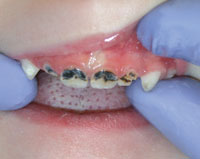 |
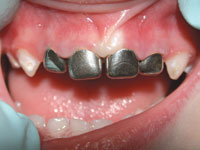 |
| Figure 4a. Neglected nursing-bottle caries in a 2-year-old child. | Figure 4b. Same patient after pulpotomies and placement of stainless steel crowns. |
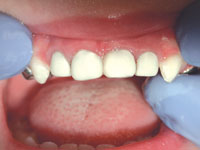 |
| Figure 4c. Same patient after opening of labial surfaces on crowns and placement of composite facings. |
Many parents are permitting their toddlers to carry around baby bottles and “sippy” cups with milk or juice, unaware of the damage the primary teeth could be suffering. By the time they get to a dentist, the maxillary primary incisors are not salvageable, or if they are, it’s necessary to perform pulpotomies and place stainless steel crowns with open faces (Figure 4a to 4c). It would be nice if these indulgences never got started, but after the fact, I believe in a “cold turkey” approach to curtailing baby bottles and other indulgences of that genre.
Young children should be supervised or monitored when brushing their teeth. Parents will frequently say (referring to their 3-year-old toddler), “He likes to brush by himself.” No! Let him do a little, and you do a little. Make a game out of it. Sing a song! Make it fun.
Note: Flossing for a 2-year-old is not as significant as it would be for a 5-year-old or a teenager. Fluoride rinses and mouthwashes are contraindicated for very young children, but fluoride treatments in the dental office at checkup time are appropriate. Dietary fluor-ide supplements should only be prescribed when the water supply is not fluoridated.
PEDIATRIC OPERATIVE DENTISTRY
The primary dentition in the young child should be treated with the same respect accorded the permanent dentition, even though “baby teeth” fall out. The dentistry should be performed comprehensively and thoroughly with the philosophy of “do it once and do it right.” All the principles of solid operative dentistry we learned in dental school should be adhered to so that the integrity of the primary teeth is preserved. If we’re doing an amalgam, thorough caries removal, extension for prevention, outline form, carving, contouring, and attention to contacts all apply. In the case of composites, proper isolation with cotton rolls, gauze, or a rubber dam is mandatory.
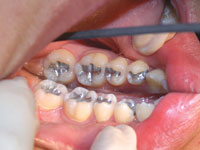 |
| Figure 5. Properly placed and maintained amalgams. |
Amalgam is still a mainstay as the restoration of choice for multisurface, deep carious lesions. I am not one of those clinicians who proudly proclaims, “I have an amalgam-free practice,” as if they are recovering alcoholics or reformed murderers. There is no sound evidence to back the unscientific, emotional criticism of amalgam. To the contrary, historically, it is the most effective and durable restoration for posterior teeth in the primary dentition (Figure 5).
Composites certainly have their place in pediatric clinical dentistry. In our practice they’re indicated for anterior restorations, as aesthetic facings for anterior stainless steel crowns, for composite crowns in conjunction with crown forms, and in less invasive carious lesions in the posterior teeth. They’re invaluable when it comes to building up fractured incisors or for the aesthetic masking of decalcification and hypoplastic spots. I have reservations about the long-term reliability of the composite materials at this point in time when it comes to multisurface restorations, even given explicit attention to proper placement technique. So I’m not ready to put all my eggs in the composite basket.
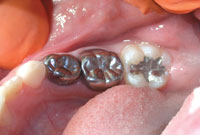 |
| Figure 6. Posterior stainless steel crowns in the mouth of 7-year-old child. |
Stainless steel crowns are the restorations of choice when dealing with primary molars badly broken down due to caries, hypoplasia, or severe decalcification, or where pulp therapy has been performed (Figure 6). The technique is easy to learn, and when placed properly, the stainless steel crown is the most predictably successful restoration in all of dentistry. (For more comprehensive detail refer to my Complete Guide to Stainless Steel Crown Technique videotape.2)
SEALANTS
The placement of sealants in primary and permanent teeth of caries-susceptible child-patients is part of a well-conceived prevention program. However, they should not be used indiscriminately. Once you place a sealant, you’re “married” to that sealant, and if part of it or all of it is washed away or chipped out after a period of time, you must touch it up or replace it. If you don’t, then debris accumulates and the child develops caries in a place he might not have otherwise. A 2-year-old caries-free patient, for example, is not necessarily a candidate for sealants. That child could very well be one who has a natural resistance to caries. Also, be sure to inform the parent that sealants only protect the occlusal surfaces, so thorough brushing and flossing and regular visits to the dentist are still essential if interproximal cavities are to be avoided.
PULP THERAPY
Pulp involvement when treating the primary dentition is a frequent occurrence, and with proper diagnosis and conscientious technique, many teeth can be saved instead of extracted. Pulp pathology, even in the face of tooth mobility, fistulas, and swelling, responds well to the 1-visit or 2-visit pulpotomy technique as long as the root structure is relatively intact. The term pulpotomy signifies the removal of the entire coronal portion of the pulp tissue. A pulpectomy (RCT) is also a possibility, but considering the high success rate of the pulpotomy, the pulpectomy may be overkill. Pulp capping is not synonymous with pulpotomy and does not enjoy the same success. In any case, it’s essential for a clinician to have a good grasp of the available pulp therapy alternatives.3
TRAUMATIC INJURIES
Injuries to the teeth are common across all age groups. These injuries should receive emergency attention. As in the case of a child who avulses a central incisor, reimplantation and splinting must take place within 24 hours or less to maximize success. Thankfully, a wide array of bonding materials has enabled us to restore fractured anterior teeth beautifully. Even if the trauma is minor in nature, for the sake of the child and the parent’s peace of mind every effort should be made to see the child as soon as possible. Better to err on the side of caution rather than dismiss it out of hand.
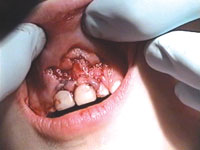 |
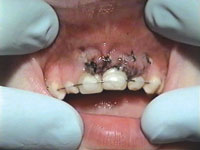 |
| Figure 7a. Three-year-old with oral trauma. Note displaced incisors and stripped gingiva and mucosa. | Figure 7b. Same child 72 hours after suturing and fixation. |
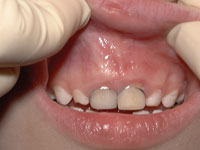 |
| Figure 7c. Same child at 6-month follow-up visit. |
Note: Take a careful history of the traumatic incident. Write a full description of the event in the record and take a radiograph and/or a photograph that can serve as a comparison reference in the future4 (Figures 7a to 7c).
ORAL HABITS
The pacifier continues to enjoy wide popularity as a means of shutting kids up. In many instances the use is intense and prolonged, and in these cases there is no doubt that it causes a combination of anterior protrusion, open bite, and a narrowing of the upper arch. The older the child is, the more difficult the weaning. It would be my wish that the child was never introduced to the pacifier, but in any case, elimination of the pacifier at the earliest opportunity should be the goal. There is no gradual method. Find a way to substitute a prize or a story or more hugs and lots of distraction, and throw it away.
Thumb sucking is a bit more difficult to deal with, but many times a passive approach to a short-term goal from dentist to child can be effective. Place a Band-Aid on the thumb (draw a happy face or sign your name on it). Ask the child to leave the bandage on, stop sucking for just 1 night, and call you in the morning because you have a big surprise. It’s the “just one night” that’s important. It’s hard to stop forever, but just 1 night is possible. One night leads to 2, leads to 3, and so on. Habit appliance therapy is ineffective and inappropriate unless the child is old enough to understand and be motivated. In any case, the appliance should not be punitive.
ERUPTION GUIDANCE, SPACE MAINTENANCE, AND EARLY ORTHODONTIC TREATMENT
When posterior primary teeth are extracted prematurely, space maintenance should be provided to prevent loss of arch length. Early orthodontic intervention could be a consideration where, for example, crowded eruption and arch constriction are involved. Early treatment may include arch expansion and/or extraction of primary teeth and subsequent space maintenance.
Caution: Eschew early treatment if the same goal can be accomplished with the all-inclusive full orthodontic regimen later. Children get appliance weary, and parents often resent what they perceive as “spending money twice for the same thing.”
CONCLUSION
Pediatric dentistry is not reserved for the pediatric specialist. On the contrary, children in the mainstream are predominantly being treated by general practitioners who owe it to their child-patients and themselves to be able to treat those children with skill, care, and confidence. The 4 installments of this series comprise a mini-view of an important area of dentistry that is often treated as an afterthought. The professional and personal satisfaction accompanied by the financial rewards and the fun should be more than enough to warrant the resolve to include more children in your practice…46 years and counting have only intensified my desire to spread the word.
References
1. Oh No! Not The Shot!…The Psychology, Art and Science of Local Anesthesia [videotape]. Chicago, Ill: Marvin Berman, DDS; 2003.
2. Complete Guide To Stainless Steel Crown Technique For Children: Easy As 1! 2! 3! [videotape]. Chicago, Ill: Marvin Berman, DDS; 1995.
3. Berman MH. Pulpotomy: the old reliable pulp therapy. Dentistry Today. December 1996;15:60-67.
4. Berman MH. Managing emergency pediatric dental trauma. Dentistry Today. 2001;20:84-91.
McDonald RE, Avery DR, Dean JA. Dentistry for the Child and Adolecent. 8th ed. St. Louis, Mo: CV Mosby; 2004.
Pinkham J, Fields HW Jr., McTigue DJ, et al (eds). Pediatric Dentistry: Infancy Through Adolescence. 3rd ed. Philadelphia, Pa: Saunders; 1999.
The author would like to express his heartfelt gratitude to Dr. Phillip Bonner for his counsel and for graciously devoting the space and attention to the subject of dentistry for children.
Dr. Berman is an internationally recognized pediatric dentist with a career as a successful practitioner and world-class lecturer spanning more than 4 decades. After hearing him speak or watching his videotapes, thousands of dentists (general practitioners as well as specialists) are using his straightforward, no nonsense approach to patient management and practice organization. Dr. Berman has been an ambassador for dentistry as a health reporter on CBS (News Radio 78), via media appearances as a consumer advisor for the ADA, the Chicago Dental Society, and the Academy of Pediatric Dentistry, and as co-author of Essentials of Modern Dental Practice. He has published numerous articles in the dental literature, as well as practice materials and education videotapes. His public relations expertise is in demand when shows like OPRAH are tackling difficult issues such as AIDS, amalgam, dental phobia, and consumer rights, and he’s still the principal dentist in a thriving practice in Chicago. For more information about Dr. Berman’s seminars, he can be reached at (773) 764-0007 or marvy18@prodigy.net.
To comment on this article, visit the discussion board at dentistrytoday.com.


